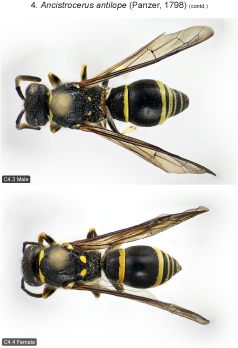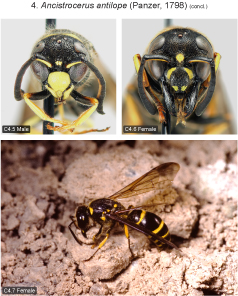
| Home | Table of contents | Keys | Species list | Glossary | Image data | PDF | Cite this article | Feedback | Updates |
Identification Atlas of the Vespidae (Hymenoptera, Aculeata) of the northeastern Nearctic region
CJAI 05, February 19, 2008
doi: 10.3752/cjai.2008.05
Matthias Buck, Stephen A. Marshall, and David K.B. Cheung
Department of Environmental Biology, University of Guelph, Guelph, Ontario, Canada N1G 2W1
Next species | Previous species | Key
4. Ancistrocerus antilope (Panzer, 1798)
Figs B3.3, 5, 37; C4.1–7.
Species recognition. Similar to the rare A. spinolae, from which it can be separated by the characters used in the key (see also under that species). Ancistrocerus antilope and A. spinolae are the only species in the genus with a strongly developed ventrolateral ridge on the propodeum.
Variation. Fore wing length 7–10 mm (♂♂), 8–12.5 mm (♀♀). Female clypeus black with a pair of dorsal and almost always with a pair of smaller ventral yellow spots. Interantennal spot of male sometimes divided, rarely absent. Mesopleuron with a yellow dorsal spot, rarely absent in male. Scutellum with a pair of yellow spots, sometimes absent in male. Terga 1–4 in female and 1–6 in male fasciate; tergum 5 in female often with a transverse apicomedial spot; fascia of tergum 6 in male not always extending to lateral margin. Sternum 2 and 3 fasciate in female, sometimes more or less interrupted on sternum 3; sternum 4 and rarely 5 with posterolateral spots; male sterna 2–6 fasciate.
Distribution. Canada: all provinces. Entire continental U.S. excluding AK, AL, FL. Palaearctic region from Europe to Siberia (Krombein 1979). Three subspecies have been described from the western Nearctic: ssp. allegrus Bequaert, 1943 (CO, OR, CA), ssp. navajo Bequaert, 1925 (MT to NM, CA), and ssp. spenceri Bequaert, 1943 (BC).
Biology. Nests in borings in wood, in stems of sumac and elder, and in abandoned mud-dauber nests. Closing plugs and cell partitions are made of mud. Preys on caterpillars of Oecophoridae, Amphisbatidae, Gelechiidae, Tortricidae, Pyralidae and “Noctuidae” (in the traditional sense) (Krombein 1967, 1979).
Next species | Previous species | Key
| Home | Table of contents | Keys | Species list | Glossary | Image data | PDF | Cite this article | Feedback | Updates |



